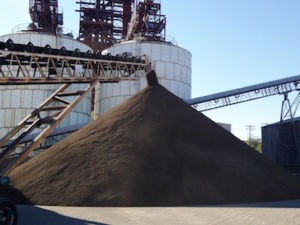
Lightweight fine aggregate for internal curing is not new. But it has been slow to gain traction in everyday use. Even so, I have a feeling it will become more common in years to come.
In October 2017, Bill Palmer wrote a blog post for Concrete Construction magazine, “The Best Thing Since Water-Cement Ratio.” He was referring to internal concrete curing using lightweight aggregate.
At the 2015 Minnesota Concrete Conference, Dr. Jason Weiss of Oregon State University’s School of Civil and Construction Engineering, gave the talk Ready, Set, Implement: Lessons Learned from 10 years of Internal Curing. I still remember his talk, and it was the second to last talk of a long day. Palmer, Weiss, and many others advocate internal curing with lightweight aggregate.
Internal curing with lightweight fine aggregate works, isn’t difficult to implement, and there is no reason why we shouldn’t all jump on the bandwagon. It isn’t a proprietary technology with secrets or complicated process mechanisms.
Benefits of better curing
Concrete slabs crack due to drying- and autonomous shrinkage, warping, and curling. Internal curing with fine lightweight aggregate mitigates cracking by reducing shrinkage, warping, and curling. And the cracks that do form are fewer and/or narrower than in conventional concrete slabs.
Lightweight aggregate is mostly pre-wetted expanded clay, shale, or slate fine aggregate. Other materials are used, but not as frequently. Lightweight fine aggregate is preferable to coarse aggregate because it provides an even distribution of water.
Water moves from the aggregate pores to the pores in the paste fraction of the concrete, further hydrating the cement. Water in the aggregates does not count in the water-to-cement ratio because it does not start assisting the concrete until after initial set.
Use specifications on internal curing with lightweight aggregate
ASTM C1761 Standard Specification for Lightweight Aggregate for Internal Curing of Concrete provides guidance on how to purchase and test lightweight fine aggregate. It also tells how to determine the percent replacement of standard fine aggregate with lightweight fine aggregate. The FHWA Tech Brief “Internal Curing for Concrete Pavements” July 2016 FHWA-HIF-16-006, suggests that saturated lightweight fines can replace up to 10% of fine aggregate.
When substituting lightweight fines for standard fine aggregate, the mixture, batching, testing, and placement do not change. And you can still use the pressure meter to determine the air content of the fresh concrete.
The technology is starting to gain use in more places. Locally, the Minnesota Department of Transportation has implemented the use of lightweight fine aggregate in some of its recently-placed bridge deck mixtures.
